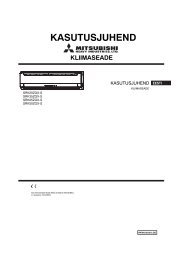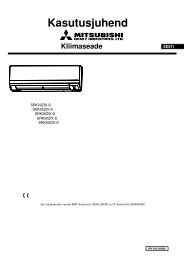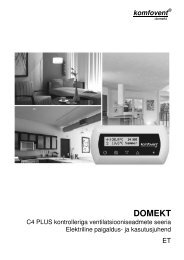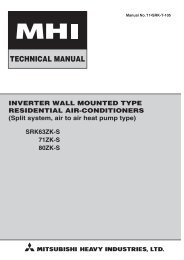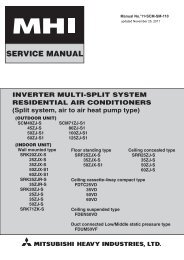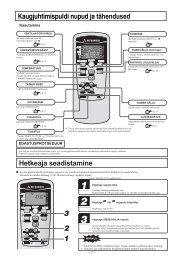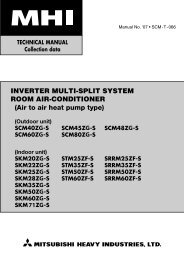DATA BOOK - BVT Partners OÃ
DATA BOOK - BVT Partners OÃ
DATA BOOK - BVT Partners OÃ
You also want an ePaper? Increase the reach of your titles
YUMPU automatically turns print PDFs into web optimized ePapers that Google loves.
5Duct Work1A corrugated board (for preventing sputtering) is attached to the main body of the air conditioner(on the outlet port). Do not remove it until connecting the duct.●An air filter can be provided on the main body of the air conditioner (on the inlet port). Removeit when connecting the duct on the inlet port.2Blowout duct●Use rectangular duct to connect with unit.Duct size for each unit is as shown below.●Duct should be at their minimum length.●We recommend to use sound and heat insulated duct to prevent it from condensation.●Connect duct to unit before ceiling attachment.3Inlet port●When shipped the inlet port lies on the back.●When connecting the duct to the inlet port, remove the air filter if it is fitted to the inlet port.●When placing the inlet port to carry out suction from the bottom side, use the followingprocedure to replace the suction duct joint and the bottom plate.●Remove the screws which fasten thebottom plate and the duct joint on theinlet port side of the unit.●Replace the removed bottom plateand duct joint.●Fit the duct join with a screw; fit the bottom plate.●Make sure to insulate the duct to prevent dewing on it.4Install the specific blowout duct in a location where the air willcirculate to the entire room.●Conduct the installation of the specific blowout hole and theconnection of the duct before attaching them to the ceiling.●Insulate the area where the duct is secured by a band for dewcondensation prevention.Secure with a band, etc.Blowoutduct5Make sure provide an inspection hole on the ceiling. It is indispensable to service elecricequipment, motor, functional components and cleaning of heat exchanger.Bad example of duct workSingle typeMulti typeABBAir conditioner main unitBlow outletBlowout duct(optional or marketed item)Suction grille(option)5022-56682172Suction duct(marketed item)Inspection holeCeiling suriaceSuction hole(marketed item)(with air filter)Suction grille(Locality)1If a duct is not provided at the suction side but it is substituted with the space over the ceiling,humidity in the space will increase by the influence of capacity of ventilation fan, strength ofwind blowing against the out door air louver, weather (rainy day) and others.a)Moisture in air is likely to condense over the external plates of the unit and to drip on theceiling. Unit should be operated under the conditions as listed in the above table and withinthe limitation of wind volume. When the building is a concrete structure, especially immediatelyafter the construction, humidity tends to rise even if the space over the ceiling is notsubstituted in place of a duct. In such occasion, it is necessary to insulate the entire unit withglass wool (25mm). (Use a wire net or equivalent to hold the glass wool in place.)b)It may run out the allowable limit of unit operation (Example: When outdoor air temperatureis 35°C DB, suction air temperature is 27°C WB) and it could result in such troubles ascompressor overload, etc..c)There is a possibility that the blow air volume may exceed the allowable range of operationdue to the capacity of ventilation fan or strength of wind blowing against external air louverso that drainage from be heat exchanger may fall to reach the drain pan but leak outside(Example: drip on to the ceiling) with consequential water leakage in the room.2If vibration damping is not conducted between the unit and the duct, and between the unit andthe slab, vibration will be transmitted to the duct and vibration noise may occur. Also, vibrationmay be transmitted from the unit to the slab. Vibration damping must be performed.Bad example of duct workAFor ventilation60-7171-90882172Louver tooutdoor air100-140112-1401470590'11 • SCM-DB-1095Duct Work (continued)Connecting the air intake/vent ducts1Fresh Air Intake[for air intake duct only]Side fresh air intake hole○Use the side fresh air intake hole, or supplythrough a part of the suction duct.Fresh air intake through thesuction duct[for simultaneous air intake/vent]○Intake air through the suction duct.Air vent hole(the side cannot be used)Fresh air intake through thesuction duct2Air VentAir vent hole○Use the side air vent hole.(always use together with the air intake)Fresh air intake through thesuction duct○Insulate the duct to protect it from dew condensation.6Refrigerant pipeCaution●Use the new refrigerant pipe.When re-using the existing pipe system for R22 or R407C, pay attention to the following items.・Change the flare nuts with the attached ones (JIS category 2), and reprocess the flare parts.・Do not use thin-walled pipes.●Use phosphorus deoxidized copper alloy seamless pipe (C1220T specified in JIS H3300) for refrigeration pipe installation.In addition, make sure there is no damage both inside and outside of the pipe, and no harmfulsubstances such as sulfur, oxide, dust or a contaminant stuck on the pipes.●Do not use any refrigerant other than R410A.Using other refrigerant except R410A (R22 etc.) may degrade inside refrigeration oil. And air getting intorefrigeration circuit may cause over-pressure and resultant it may result in bursting, etc.●Store the copper pipes indoors and seal the both end of them until they are brazed in order to avoid any dust, dirt orwater getting into pipe. Otherwise it will cause degradation of refrigeration oil and compressor breakdown, etc.●Use special tools for R410 refrigerant.Piping workRefrigerant pipeWhen conducting piping work, make sure to allow the pipesto be aligned in a straight line for at least 250 mm, as shown250mm(Section where attached in the left illustration. (This is necessary for the drain pumpin a straight line) to function)Work procedure1. Remove the flare nut and blind flanges on the pipe of the indoor unit.※ Make sure to loosen the flare nut with holding the nut on pipe side with a spanner and giving torque to thenut with another spanner in order to avoid unexpected stress to the copper pipe, and then remove them.(Gas may come out at this time, but it is not abnormal.)● Pay attention whether the flare nut pops out. (as the indoor unit is sometimes pressured.)2. Make a flare on liquid pipe and gas pipe, and connect the refrigeration pipes on the indoor unit.※Bend the pipe with as big radius as possible and do not bend the pipe repeatedly. In addition,do not twist and crush the pipes.※Do a flare connection as follows:● Make sure to loosen the flare nut with holding the nut on pipe side with a spanner and givingtorque to the nut with another spanner in order to avoid unexpected stress to the copperpipe, and then remove them.● When fastening the flare nut, align the refrigeration pipe with the center of flare nut, screwthe nut for 3-4 times by hand and then tighten it by spanner with the specified torquementioned in the table below. Make sure to hold the pipe on the indoor unit securely by aspanner when tightening the nut in order to avoid unexpected stress on the copper pipe.3. Cover the flare connection part of the indoor unit with attached insulation material after a gasleakage inspection, and tighten both ends with attached straps.●Make sure to insulate both gas pipes and liquid pipes completely.※ Incomplete insulation may cause dew condensation or water dropping.4. Refrigerant is charged in the outdoor unit.As for the additional refrigerant charge for the indoor unit and piping, refer to the installationmanual attached to the outdoor unit.Pipe diameter Tightening torque N·m Strap (Accessory) Pipe cover (Accessory)φ 6.3514 to 18φ 9.5234 to 42φ 12.749 to 61φ 15.8868 to 82φ 19.05100 to 120The thickness of insulation should be 20mm or more.- 136 -(Pipe side)(Pipe side)(Pipe side)7DCaut● InIm● DasIn● C● In● Co● MadinWork1. MdAw●●F52. Pe※●●3. Ma●●●4. I●




